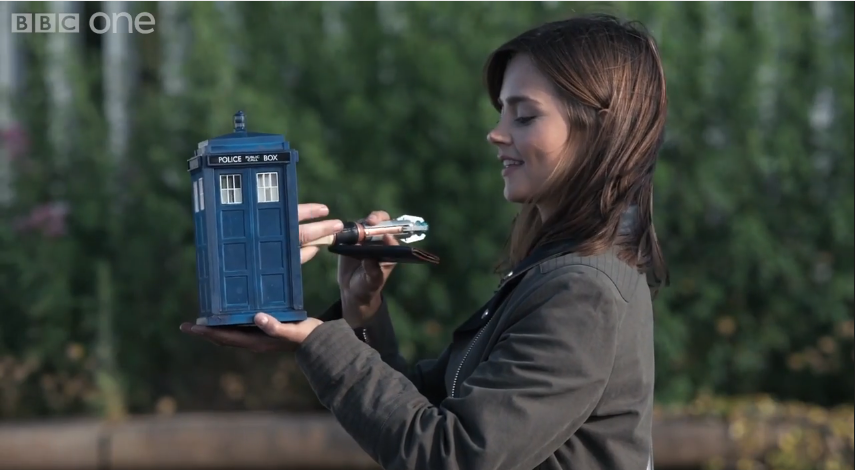 |
| Community Service worker Rigsey wonders about the mural. |
Another Unseen Enemy.
This is the second story in as many weeks by writer Jamie Mathieson and his story, Mummy On The Orient Express seemed to show the type of story he likes to write. The Doctor, Clara and the bystanders facing an unseen, unknown, something. Flatline has us witnessing a similar threat albeit something light years away from a Mummy.
Some Rather Peculiar Readings.
The Doctor is about to drop Clara off at her usual spot when the Doctor notices some very unusual readings on the TARDIS console. Clara notices something even more disturbing, the TARDIS doors have gotten smaller. When they both squeeze themselves outside they discover the TARDIS has begun to shrink (think of the diminishing TARDIS with a trapped Tom Baker in Logopolis and you'll understand.). The Doctor gets back into the TARDIS before it becomes too much smaller and tells Clara to look around for anything unusual. Clara begins walking towards a railway underpass which also names the city they have landed in as Bristol. Clara notices a lot of flowers and condolence cards leaning against an embankment. A group of men performing community service are cleaning up the graffiti around the railway underpass. One of the workers, Rigsey notices Clara and assumes she is one of those people who have who have lost someone in the recent disappearances and that she has come to view the recent wall mural of what appears to be pictures of the missing people. After learning this, Clara returns to report her findings to the Doctor.
Smaller Still.
 | |||||
| An ever diminishing TARDIS. |
On returning to the TARDIS, Clara discovers it has shrunk even further, down to the size of a model. The Doctor is now effectively trapped inside the TARDIS and must now rely on Clara to do the investigating, making her "Doctor for A Day". The Doctor squeezes his fingers out to hand Clara the sonic screwdriver, psychic paper and a two way earpiece so she can keep in communication with the Doctor. Clara now carries the TARDIS in her handbag whilst the Doctor directs her to the most recent energy source.
Clara tells Rigsey she is "Doctor Oswald" investigating the disappearances. Rigsey says he can get her into the flat of one of the victims. The flat had been locked from the inside and they can't find anything but there is an usual desert looking wallpaper on one of the walls.
The 2D creatures have been dissecting humans in an effort to understand three dimensional life forms.
At that moment the 2D creatures begin to emerge from the walls and floors. Rigsey and Clara jump onto retro style chair hanging from the ceiling but their weight begins to pull the fixture out. Using the chair as a pendulum they manage to smash it through the window and escape to safety.
the Doctor still isn't convinced that the 2D are hostile and that perhaps they have been dissecting humans in order to discover how to communicate with humans. The Doctor tells Clara how to try and communicate with them using mathematics. When they hear the number 22 through the speakers the worker with that badge number is taken by them.
The survivors then escape through an unused maintenance tunnel.
Clara tells Rigsey she is "Doctor Oswald" investigating the disappearances. Rigsey says he can get her into the flat of one of the victims. The flat had been locked from the inside and they can't find anything but there is an usual desert looking wallpaper on one of the walls.
The Appearance of the 2D.
Rigsey tells Clara he can get them help from the local constabulary to go inside the flat of the first disappearance.PC Forrest comes into the flat of the first victim where Clara uses the psychic paper to tell her that's she's from MI5. The constable investigates one of the rooms and then screams as the 2D emerge from the walls and begin to dissipate her through the floor. When they enter the room Rigsey and Clara don't see any sign of PC Forrest except for her torch laying on the rug. Clara notices that there is another of those abstract murals on the walls which the Doctor views with the TARDIS scanner. It is then the Doctor realises that the mural is actually PC Forrest's nervous system and the other mural was in fact a close up of human skin.The 2D creatures have been dissecting humans in an effort to understand three dimensional life forms.
At that moment the 2D creatures begin to emerge from the walls and floors. Rigsey and Clara jump onto retro style chair hanging from the ceiling but their weight begins to pull the fixture out. Using the chair as a pendulum they manage to smash it through the window and escape to safety.
More Than A Mural.
Returning to the group of Community Service workers, Clara and Rigsey see that they are just about to paint over the underpass murals. The Doctor concludes that the 2D have been using the mural images to hide behind, at that instant the creatures shimmer into existence and take one of the work crew. Clara leads the rest into an engine repair room.the Doctor still isn't convinced that the 2D are hostile and that perhaps they have been dissecting humans in order to discover how to communicate with humans. The Doctor tells Clara how to try and communicate with them using mathematics. When they hear the number 22 through the speakers the worker with that badge number is taken by them.
The survivors then escape through an unused maintenance tunnel.








